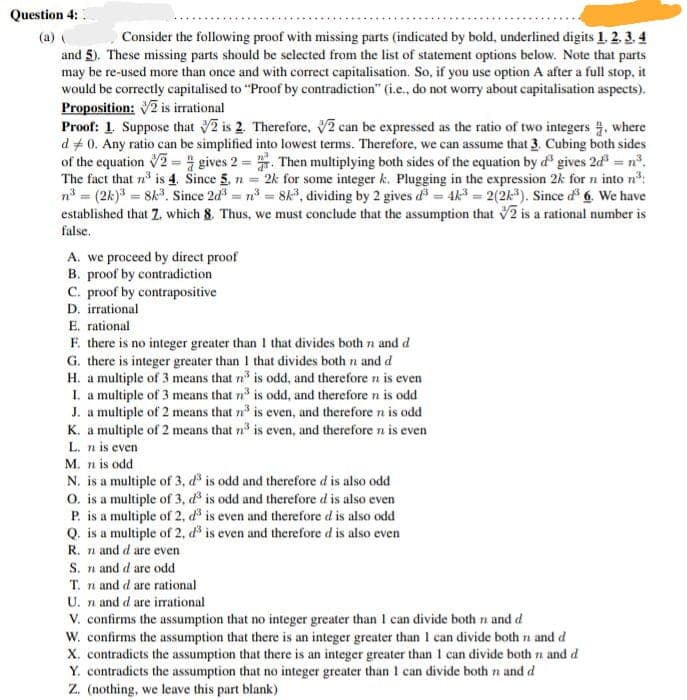(a) ( Consider the following proof with missing parts (indicated by bold, underlined digits 1. 2. 3. 4 and 5). These missing parts should be selected from the list of statement options below. Note that parts may be re-used more than once and with correct capitalisation. So, if you use option A after a full stop, it would be correctly capitalised to "Proof by contradiction" (i.e., do not worry about capitalisation aspects). Proposition: 2 is irrational 10 16
(a) ( Consider the following proof with missing parts (indicated by bold, underlined digits 1. 2. 3. 4 and 5). These missing parts should be selected from the list of statement options below. Note that parts may be re-used more than once and with correct capitalisation. So, if you use option A after a full stop, it would be correctly capitalised to "Proof by contradiction" (i.e., do not worry about capitalisation aspects). Proposition: 2 is irrational 10 16
Algebra for College Students
10th Edition
ISBN:9781285195780
Author:Jerome E. Kaufmann, Karen L. Schwitters
Publisher:Jerome E. Kaufmann, Karen L. Schwitters
Chapter14: Sequences And Mathematical Induction
Section14.4: Mathematical Induction
Problem 19PS
Related questions
Question
100%
Q4 ( a )
Plz do exactly according to question requirements plz and take a thumb up

Transcribed Image Text:Question 4:
(a) (
Consider the following proof with missing parts (indicated by bold, underlined digits 1. 2. 3. 4
and 5). These missing parts should be selected from the list of statement options below. Note that parts
may be re-used more than once and with correct capitalisation. So, if you use option A after a full stop, it
would be correctly capitalised to "Proof by contradiction" (i.e., do not worry about capitalisation aspects).
Proposition: 2 is irrational
Proof: 1. Suppose that 2 is 2. Therefore, 2 can be expressed as the ratio of two integers, where
d# 0. Any ratio can be simplified into lowest terms. Therefore, we can assume that 3. Cubing both sides
of the equation 2 gives 2. Then multiplying both sides of the equation by d³ gives 2d³ = n³.
The fact that n³ is 4. Since 5, n = 2k for some integer k. Plugging in the expression 2k for n into n³:
n³ = (2k)³ = 8k³. Since 2d³= n³ = 8k³, dividing by 2 gives d³= 4k³= 2(2k³). Since ď³ 6. We have
established that 7. which 8. Thus, we must conclude that the assumption that 2 is a rational number is
false.
A. we proceed by direct proof
B. proof by contradiction
C. proof by contrapositive
D. irrational
E. rational
F. there is no integer greater than 1 that divides both n and d
G. there is integer greater than 1 that divides both n and d
H. a multiple of 3 means that n³ is odd, and therefore n is even
I. a multiple of 3 means that n³ is odd, and therefore n is odd
J. a multiple of 2 means that n³ is even, and therefore n is odd
K. a multiple of 2 means that n³ is even, and therefore n is even
L. n is even
M. nis odd
N. is a multiple of 3, d³ is odd and therefore d is also odd
O. is a multiple of 3, d³ is odd and therefore d is also even
P. is a multiple of 2, d³ is even and therefore d is also odd
Q. is a multiple of 2, d³ is even and therefore d is also even
R. n and d are even
S. n and d are odd
T. n and d are rational
U. n and d are irrational
V. confirms the assumption that no integer greater than I can divide both n and d
W. confirms the assumption that there is an integer greater than I can divide both n and d
X. contradicts the assumption that there is an integer greater than 1 can divide both 7 and d
Y. contradicts the assumption that no integer greater than I can divide both n and d
Z. (nothing, we leave this part blank)
Expert Solution
This question has been solved!
Explore an expertly crafted, step-by-step solution for a thorough understanding of key concepts.
This is a popular solution!
Trending now
This is a popular solution!
Step by step
Solved in 3 steps

Recommended textbooks for you

Algebra for College Students
Algebra
ISBN:
9781285195780
Author:
Jerome E. Kaufmann, Karen L. Schwitters
Publisher:
Cengage Learning

Elements Of Modern Algebra
Algebra
ISBN:
9781285463230
Author:
Gilbert, Linda, Jimmie
Publisher:
Cengage Learning,

Algebra for College Students
Algebra
ISBN:
9781285195780
Author:
Jerome E. Kaufmann, Karen L. Schwitters
Publisher:
Cengage Learning

Elements Of Modern Algebra
Algebra
ISBN:
9781285463230
Author:
Gilbert, Linda, Jimmie
Publisher:
Cengage Learning,